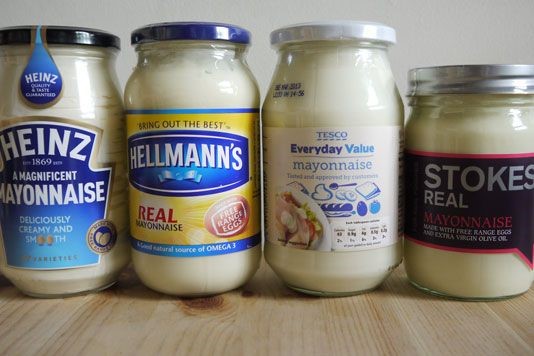Basic Britain: Mayonnaise

Whether you use it for dunking chips in or alongside a salad, mayonnaise is a store cupboard essential. But what compromise do you make by buying budget? Laura Rowe investigates.
In this new era of austerity we’re all shopping that little bit more savvy. Nowadays a product has to deliver. But have you reverted to the supermarket budget ranges yet? Back in April Tesco rebranded its famed red and blue striped Value range to the new, stylish Everyday Value collection. Here we test out its Mayonnaise up against the brand leaders.
You’ve got to be yolking
As those of us who’ve got the time or inclination will know, mayonnaise is actually very simple to make. It can be whipped up with as little as two ingredients, egg and oil – although a squeeze of lemon juice and a pinch of salt take it to another level – and once you’ve mastered the trick of combining these two together without causing it to curdle, you’ll never look back. Try Mat Follas’ blender trick for quick (we’re talking 30 seconds) results. But fresh mayonnaise is high in fat, doesn’t last long, and who doesn’t have a mayo emergency now and again... I tested Hellmann’s Mayonnaise (£1.50/400g) Heinz Mayonnaise (£1.85/430g), Tesco Everyday Value Mayonnaise (48p/500ml) and Stokes Mayonnaise (£3.15/345g).
What’s in a jar?
 Hellmann’s keeps its ingredients relatively simple with 77% vegetable oil (which on further investigation is actually rapeseed oil), water, free-range egg and egg yolk (8%), spirit vinegar, salt, sugar, lemon juice, flavouring, antioxidant and paprika extract. I’m told “the antioxidant is needed to prevent rancidity in the oil”.
Hellmann’s keeps its ingredients relatively simple with 77% vegetable oil (which on further investigation is actually rapeseed oil), water, free-range egg and egg yolk (8%), spirit vinegar, salt, sugar, lemon juice, flavouring, antioxidant and paprika extract. I’m told “the antioxidant is needed to prevent rancidity in the oil”.
Heinz uses 70% vegetable oil (specific oils aren’t specified to “ensure [Heinz] meets the recipe specifications whilst avoiding potential supply issues”), and again water, spirit vinegar, salt and sugar with free-range egg yolks (5%). This time though there is also the addition of mustard seeds, spice, xantham gum and guar gum, (which are included, according to Heinz, to “stabilise the mix of oil and water”) and an antioxidant.
Stokes keeps its mayo all natural, with rapeseed oil (75%), free-range whole egg (12%), water, extra virgin olive oil (5%), unrefined raw cane sugar, acetic acid (to give it its sharp flavour), Dead Sea salt and mustard flour.
Tesco Everyday Value, meanwhile, lists its ingredients like so: water, vegetable oil (25%), glucose-fructose syrup, modified maize starch, spirit vinegar, egg yolk (2%), salt substitute (potassium chloride), lactic acid, preservative (sorbic acid), stabilisers (xantham gum, guar gum), colour (lutein), flavouring (contains mustard). Tesco wasn’t able to provide information on whether the eggs used in its mayo were free-range.
Taste
You’ll probably be shocked to read that all of the mayonnaises – even the 48p Tesco jar – taste surprisingly similar. Hellmann’s tastes familiar (it should do as the UK and Ireland’s number-one mayonnaise) with its distinctive tang.
Heinz is slightly sweet but still sharp. Tesco stands up well, and certainly doesn’t feel like a third of the quality, and has a slight mustardy flavour. And Stokes tastes the most homemade, perhaps due to the blend of oils (rapeseed and olive) but in a blind tasting I’m not sure you would guess it is the most expensive. It justifies its price tag by the “quality of the ingredients”, which in turn means it requires “much less salt” than other mayos (see below). It is also only made in small batches.
Consistency
Aside from taste, one of the most satisfying things about mayo is its texture and while American, 97-year-old brand Hellmann’s has crafted its signature product to the perfect chip-dipping consistency – thick and creamy and easily dolloped – Heinz, too, is smooth and silky. Tesco does the job nicely (although if we are being really picky it’s a bit more claggy and leaves a slight residue in the mouth), while Stokes is a lot looser, more like a French-style mayonnaise or salad dressing.
The damage
The biggest difference, however, with all of these mayos is the calories. Stokes had the biggest fat content per 100g, with 80.6g fat and 742 calories. Hellmann’s has 79g fat/100g and 720 calories; Heinz 71.5g fat/100g and 660 calories; and Tesco, believe it or not, only has 26.7g/100g and 290 calories – that’s a third of the fat of its competitors. However, Tesco Everyday Value Mayonnaise does have the highest salt content at 1.6g/100g compared to Hellmann’s 1.5g, Heinz’s 1.1g and Stoke’s impressively low 0.6g.
So, would you go budget with mayo? Which do you value more – taste, natural ingredients, or calories? Let us know in the comments box below.
More stuff like this
How to make the perfect potato salad by Anna Marie Julyan
Comments
Be the first to comment
Do you want to comment on this article? You need to be signed in for this feature